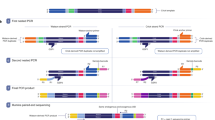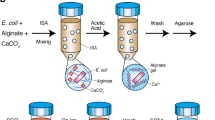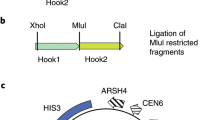Abstract
Genome sequencing currently requires DNA from pools of numerous nearly identical cells (clones), leaving the genome sequences of many difficult-to-culture microorganisms unattainable. We report a sequencing strategy that eliminates culturing of microorganisms by using real-time isothermal amplification to form polymerase clones (plones) from the DNA of single cells. Two Escherichia coli plones, analyzed by Affymetrix chip hybridization, demonstrate that plonal amplification is specific and the bias is randomly distributed. Whole-genome shotgun sequencing of Prochlorococcus MIT9312 plones showed 62% coverage of the genome from one plone at a sequencing depth of 3.5×, and 66% coverage from a second plone at a depth of 4.7 ×. Genomic regions not revealed in the initial round of sequencing are recovered by sequencing PCR amplicons derived from plonal DNA. The mutation rate in single-cell amplification is <2 × 105, better than that of current genome sequencing standards. Polymerase cloning should provide a critical tool for systematic characterization of genome diversity in the biosphere.
This is a preview of subscription content, access via your institution
Access options
Subscribe to this journal
Receive 12 print issues and online access
$209.00 per year
only $17.42 per issue
Buy this article
- Purchase on Springer Link
- Instant access to full article PDF
Prices may be subject to local taxes which are calculated during checkout



Similar content being viewed by others
Accession codes
References
Shendure, J., Mitra, R.D., Varma, C. & Church, G.M. Advanced sequencing technologies: methods and goals. Nat. Rev. Genet. 5, 335–344 (2004).
Kyrpides, N.C. Genomes OnLine Database (GOLD 1.0): a monitor of complete and ongoing genome projects world-wide. Bioinformatics 15, 773–774 (1999).
Moreira, D. & Lopez-Garcia, P. The molecular ecology of microbial eukaryotes unveils a hidden world. Trends Microbiol. 10, 31–38 (2002).
Falkowski, P.G. & de Vargas, C. Genomics and evolution. Shotgun sequencing in the sea: a blast from the past? Science 304, 58–60 (2004).
Tyson, G.W. et al. Community structure and metabolism through reconstruction of microbial genomes from the environment. Nature 428, 37–43 (2004).
Venter, J.C. et al. Environmental genome shotgun sequencing of the Sargasso Sea. Science 304, 66–74 (2004).
DeLong, E.F. Microbial community genomics in the ocean. Nat. Rev. Microbiol. 3, 459–469 (2005).
Beja, O. et al. Comparative genomic analysis of archaeal genotypic variants in a single population and in two different oceanic provinces. Appl. Environ. Microbiol. 68, 335–345 (2002).
Tringe, S.G. et al. Comparative metagenomics of microbial communities. Science 308, 554–557 (2005).
Riesenfeld, C.S., Schloss, P.D. & Handelsman, J. Metagenomics: genomic analysis of microbial communities. Annu. Rev. Genet. 38, 525–552 (2004).
Rodriguez-Valera, F. Environmental genomics, the big picture? FEMS Microbiol. Lett. 231, 153–158 (2004).
Dean, F.B. et al. Comprehensive human genome amplification using multiple displacement amplification. Proc. Natl. Acad. Sci. USA 99, 5261–5266 (2002).
Hosono, S. et al. Unbiased whole-genome amplification directly from clinical samples. Genome Res. 13, 954–964 (2003).
Paez, J.G. et al. Genome coverage and sequence fidelity of phi29 polymerase-based multiple strand displacement whole genome amplification. Nucleic Acids Res. 32, e71 (2004).
Telenius, H. et al. Degenerate oligonucleotide-primed PCR: general amplification of target DNA by a single degenerate primer. Genomics 13, 718–725 (1992).
Zhang, L. et al. Whole genome amplification from a single cell: implications for genetic analysis. Proc. Natl. Acad. Sci. USA 89, 5847–5851 (1992).
Dietmaier, W. et al. Multiple mutation analyses in single tumor cells with improved whole genome amplification. Am. J. Pathol. 154, 83–95 (1999).
Nelson, J.R. et al. TempliPhi, phi29 DNA polymerase based rolling circle amplification of templates for DNA sequencing. Biotechniques Suppl., 44–47 (2002).
Lage, J.M. et al. Whole genome analysis of genetic alterations in small DNA samples using hyperbranched strand displacement amplification and array-CGH. Genome Res. 13, 294–307 (2003).
Handyside, A.H. et al. Isothermal whole genome amplification from single and small numbers of cells: a new era for preimplantation genetic diagnosis of inherited disease. Mol. Hum. Reprod. 10, 767–772 (2004).
Hellani, A. et al. Multiple displacement amplification on single cell and possible PGD applications. Mol. Hum. Reprod. 10, 847–852 (2004).
Sorensen, K.J., Turteltaub, K., Vrankovich, G., Williams, J. & Christian, A.T. Whole-genome amplification of DNA from residual cells left by incidental contact. Anal. Biochem. 324, 312–314 (2004).
Jiang, Z., Zhang, X., Deka, R. & Jin, L. Genome amplification of single sperm using multiple displacement amplification. Nucleic Acids Res. 33, e91 (2005).
Detter, J.C. et al. Isothermal strand-displacement amplification applications for high-throughput genomics. Genomics 80, 691–698 (2002).
Raghunathan, A. et al. Genomic DNA amplification from a single bacterium. Appl. Environ. Microbiol. 71, 3342–3347 (2005).
Hutchison, C.A., III, Smith, H.O., Pfannkoch, C. & Venter, J.C. Cell-free cloning using {phi}29 DNA polymerase. Proc. Natl. Acad. Sci. USA 102, 17332–17336 (2005).
Hafner, G.J., Yang, I.C., Wolter, L.C., Stafford, M.R. & Giffard, P.M. Isothermal amplification and multimerization of DNA by Bst DNA polymerase. Biotechniques 30, 852–856, 858, 860 passim (2001).
Gray, J.W. et al. High-speed chromosome sorting. Science 238, 323–329 (1987).
Chisholm, S.W., Olson, R.J., Zettler, E.R. & Goericke, R. A novel free-living prochlorophyte abundant in the oceanic euphotic zone. Nature 334, 340–343 (1988).
Partensky, F., Hess, W.R. & Vaulot, D. Prochlorococcus, a marine photosynthetic prokaryote of global significance. Microbiol. Mol. Biol. Rev. 63, 106–127 (1999).
Rocap, G. et al. Genome divergence in two Prochlorococcus ecotypes reflects oceanic niche differentiation. Nature 424, 1042–1047 (2003).
Dufresne, A. et al. Genome sequence of the cyanobacterium Prochlorococcus marinus SS120, a nearly minimal oxyphototrophic genome. Proc. Natl. Acad. Sci. USA 100, 10020–10025 (2003).
Urbach, E. & Chisholm, S.W. Genetic diversity in Prochlorococcus Populations flow-cytometrically sorted from the Sargasso Sea and Gulf Stream. Limnol. Oceanogr. 43, 1615–1630 (1998).
Panelli, S., Damiani, G., Espen, L. & Sgaramella, V. Ligation overcomes terminal underrepresentation in multiple displacement amplification of linear DNA. Biotechniques 39 174, 176, 178 passim (2005).
Shendure, J. et al. Accurate multiplex polony sequencing of an evolved bacterial genome. Science 309, 1728–1732 (2005).
Margulies, M. et al. Genome sequencing in microfabricated high-density picolitre reactors. Nature 437, 376–380 (2005).
Thompson, J.R. et al. Genotypic diversity within a natural coastal bacterioplankton population. Science 307, 1311–1313 (2005).
Acinas, S.G. et al. Fine-scale phylogenetic architecture of a complex bacterial community. Nature 430, 551–554 (2004).
Dean, F.B., Nelson, J.R., Giesler, T.L. & Lasken, R.S. Rapid amplification of plasmid and phage DNA using Phi 29 DNA polymerase and multiply-primed rolling circle amplification. Genome Res. 11, 1095–1099 (2001).
Yu, D. et al. An efficient recombination system for chromosome engineering in Escherichia coli. Proc. Natl. Acad. Sci. USA 97, 5978–5983 (2000).
Acknowledgements
We thank J. Shendure, M. Umbarger and M. Wright for critical comments on the manuscript; C. Detter (DOE-JGI) for technical assistance on sequencing library construction. We would also like to thank the US Department of Energy for Genomes-to-Life Center support (G.M.C. and S.W.C.), and the National Science Foundation and the Moore Foundation for additional support (S.W.C.).
Author information
Authors and Affiliations
Contributions
A.C.M. contributed to Prochlorococcus single-cell amplification, data analyses and manuscript writing, N.B.R. contributed to E. coli single-cell amplification, Affymetrix gene-chip analyses and writing, K.W.B. contributed to genome assembly, J.M. contributed to the development of sequencing library construction protocol, S.W.C. contributed to the design of the project and writing. K.Z. contributed to the development of the real-time amplification method, polymerase cloning, characterization of plones by Affymetrix gene-chip analyses and genome sequencing, development of the library construction protocol, data analyses and manuscript writing. S.W.C. and G.M.C. contributed to the planning and design of the project, and manuscript writing.
Note: Supplementary information is available on the Nature Biotechnology website.
Corresponding author
Ethics declarations
Competing interests
The authors declare no competing financial interests.
Supplementary information
Supplementary Fig. 1
Quantification of amplification background with real-time MDA. (PDF 98 kb)
Supplementary Fig. 2
Achieving ultra-low background amplification. (PDF 87 kb)
Supplementary Fig. 3
The effect of primer concentration and enzyme amount on the dynamics of isothermal amplification. (PDF 82 kb)
Supplementary Fig. 4
E. coli plones amplified with a restricted-randomized hexamer D6. (PDF 85 kb)
Supplementary Fig. 5
“Dips” of ratio profiles corresponds to genomic regions with low copy numbers. (PDF 72 kb)
Supplementary Fig. 6
Breaking chimeric sequences improved genome assembly. (PDF 86 kb)
Supplementary Fig. 7
Investigation of the source of chimera. (PDF 79 kb)
Supplementary Fig. 8
Genome coverage as function of genome sequencing effort. (PDF 63 kb)
Supplementary Fig. 9
Uneven read depth due to amplification bias. (PDF 163 kb)
Supplementary Fig. 10
Recovering sequences within gaps with PCR. (PDF 85 kb)
Supplementary Fig. 11
Preliminary characterization of two Prochlorococcus plones from an ocean sample. (PDF 100 kb)
Supplementary Table 1
Amplification dynamics and endogenous background of seven primers. (PDF 74 kb)
Supplementary Note
Achieving ultra-low background amplification on single cells. (PDF 107 kb)
Rights and permissions
About this article
Cite this article
Zhang, K., Martiny, A., Reppas, N. et al. Sequencing genomes from single cells by polymerase cloning. Nat Biotechnol 24, 680–686 (2006). https://doi.org/10.1038/nbt1214
Received:
Accepted:
Published:
Issue Date:
DOI: https://doi.org/10.1038/nbt1214
This article is cited by
-
Tools for microbial single-cell genomics for obtaining uncultured microbial genomes
Biophysical Reviews (2024)
-
Variation in haplotypes in single cysts of assemblages C and D, but not of assemblage E of Giardia duodenalis
BMC Microbiology (2022)
-
Agarose gel microcapsules enable easy-to-prepare, picolitre-scale, single-cell genomics, yielding high-coverage genome sequences
Scientific Reports (2022)
-
Uniform genomic data analysis in the NCI Genomic Data Commons
Nature Communications (2021)
-
Full-length sequencing of circular DNA viruses and extrachromosomal circular DNA using CIDER-Seq
Nature Protocols (2020)



